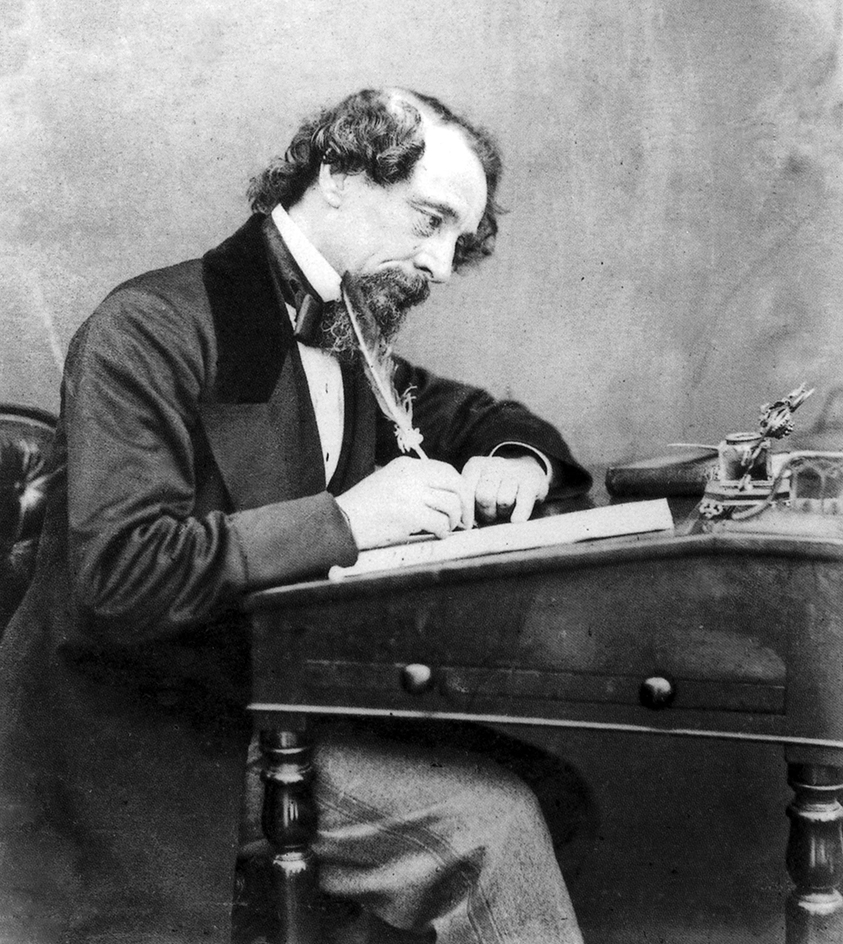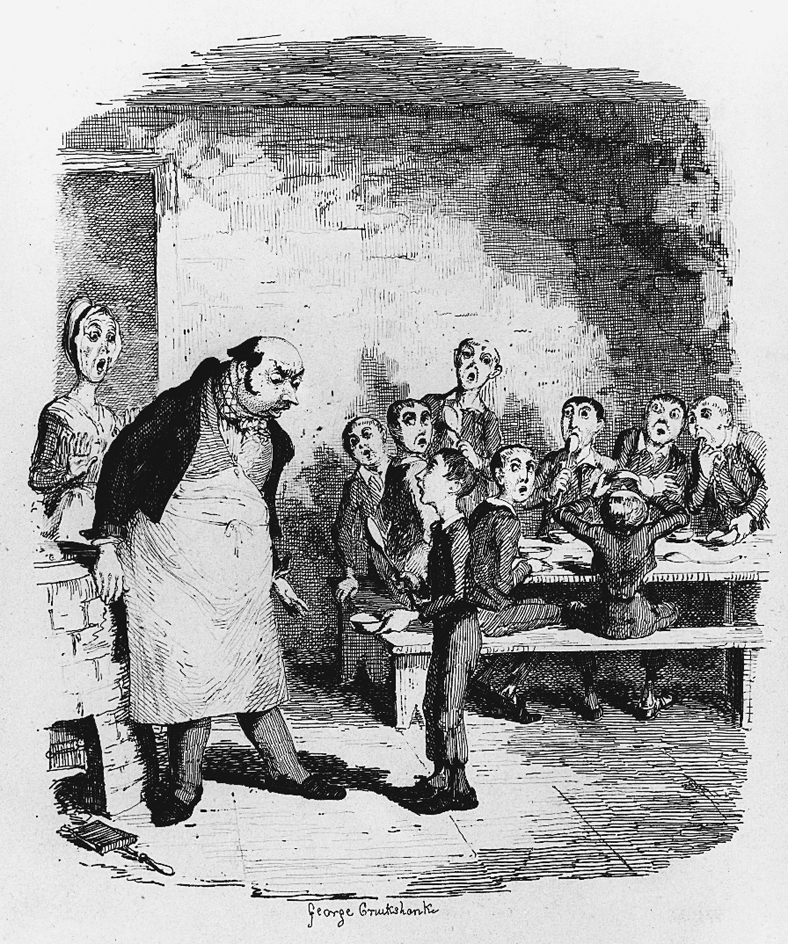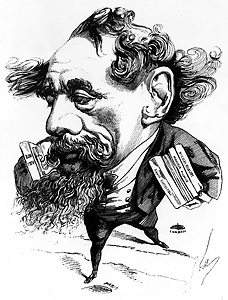Dickens, Charles (1812-1870), was a great English novelist and one of the most popular writers of all time. His best-known books include A Christmas Carol, David Copperfield, Great Expectations, Oliver Twist, The Pickwick Papers, and A Tale of Two Cities. Dickens created some of the most famous characters in English literature. He also created scenes and descriptions of places that have long delighted readers. Dickens was a keen observer of life and had a great understanding of humanity, especially of young people. He sympathized with the poor and helpless, and mocked and criticized the selfish, the greedy, and the cruel.

Dickens was also a wonderfully inventive comic artist. The warmth and humor of his personality appear in all his works. Perhaps in no other large body of fiction does the reader receive so strong and agreeable an impression of the person behind the story.
Dickens’s life
Charles John Huffam Dickens was born in Portsmouth, England, on Feb. 7, 1812. He moved with his family to London when he was about two years old. Many of the events and people in Dickens’s books are based on events and people in his life. Dickens’s father, John Dickens, was a poor and easygoing clerk who worked for the navy. John served in some respects as the model for Wilkins Micawber in David Copperfield. He spent time in prison for debt, an event that Charles re-created in Little Dorrit.
Even when John was free, he lacked the money to support his family adequately. At the age of 12, Charles worked in a London factory pasting labels on bottles of shoe polish. He held the job only a few months, but the misery of that experience remained with him all his life.
Dickens attended school off and on until he was 15, and then left for good. He enjoyed reading and was especially fond of adventure stories, fairy tales, and novels. He was influenced by such earlier English writers as William Shakespeare, Tobias Smollett, and Henry Fielding. However, most of the knowledge he later used as an author came from his observation of life around him.
Dickens became a newspaper reporter in the late 1820’s. He specialized in covering debates in Parliament and also wrote feature articles. His work as a reporter sharpened his naturally keen ear for conversation and helped develop his skill in portraying his characters’ speech realistically. It also increased his ability to observe and to write swiftly and clearly. Dickens’s first book, Sketches by Boz (1836), consisted of articles he wrote for the Monthly Magazine and the London Evening Chronicle. These descriptions, fictional portraits, and short stories surveyed manners and conditions of the time.
Literary success.
Dickens won his first literary fame with The Posthumous Papers of the Pickwick Club. Published in monthly parts in 1836 and 1837, the book describes the humorous adventures and misadventures of a group of slightly eccentric characters in London and the English countryside. After a slow start, The Pickwick Papers–as the book is usually called—gained a popularity seldom matched in the history of literature. At 24, Dickens suddenly found himself famous. He remained so until his death.

Dickens founded and edited two highly successful weekly magazines. He edited Household Words from 1850 to 1859 and All the Year Round from 1859 to his death. As a public figure, Dickens was constantly in the news, and was recognized and honored wherever he went. He was famous in America as well as in Britain, and he toured the United States in 1842 and in 1867 and 1868.
Personal life.
Personal unhappiness marred Dickens’s public success. In 1836, he married Catherine Hogarth. Catherine had a sister, Mary, who died in 1837. Dickens’s grief at Mary’s death has led some scholars to believe that he loved Mary more than his wife. Catherine was a good woman but lacked great intelligence. She and Dickens had 10 children. The couple separated in 1858.
Dickens had remarkable mental and physical energy. He recorded his activities in thousands of letters, many of which make delightful reading. He spent much of his crowded social life with friends from the worlds of art and literature. Dickens enjoyed drama and went to the theater as often as he could. When he was rich and famous, he made a hobby of producing and acting in amateur theatrical productions. He had great success giving public readings of his works. Dickens’s gift for creating dramatic scenes in his novels can be traced to his love for the theater.
Besides writing, editing, and touring as a dramatic reader, Dickens busied himself with various charities. These charities included schools for poor children and a loan society to enable the poor to move to Australia. Dickens often walked for hours to work off his remaining energy. He came to know the streets and alleys of London better, perhaps, than any other person of his time.
Dickens’s health began to decline about 1865, and he died of a stroke on June 9, 1870.
Dickens’s books
Dickens wrote 20 novels (including 5 short Christmas books), and many sketches, travel books, and other nonfiction works. Not all of his books were best sellers, but the most popular ones broke all sales records for the time. Most of his novels were published in sections.
The first phase.
After the success of The Pickwick Papers, Dickens turned to more serious themes and plots. However, he always introduced enough humor to keep his books entertaining.
Oliver Twist (1837-1839) describes the adventures of a poor orphan boy. The book was noted for its sensational presentation of London’s criminal world and for its attack on England’s mistreatment of the poor. 
In Nicholas Nickleby (1838-1839), Dickens criticized greedy proprietors of private schools, who treated students brutally and taught them nothing.
The Old Curiosity Shop (1840-1841) is less respected today than when it was first published, largely because the death scene of Little Nell seems sentimental to modern tastes.
Barnaby Rudge (1841) is a historical novel that deals with a series of riots in London in 1780. Martin Chuzzlewit (1843-1844) is one of two books that Dickens based on his first trip to America. The other is the travel book American Notes (1842). Dickens intended Martin Chuzzlewit to be a study of many forms of selfishness. But it is best known for its unflattering picture of the crudeness of American manners and for its comic characters. Two of its finest creations are the hypocrite Pecksniff and the chattering, alcoholic midwife Sairey Gamp.
Dickens wrote his five “Christmas books” during the 1840’s. The first, A Christmas Carol (1843), is one of the most famous stories ever written. In the book, three ghosts show the old miser Ebenezer Scrooge his past, present, and future. Realizing that he has been living a life of greed, Scrooge changes into a warm and unselfish person. The other Christmas books are The Chimes (1844), The Cricket on the Hearth (1845), The Battle of Life (1846), and The Haunted Man (1848).
The second phase.
During the 1840’s, Dickens’s view of Victorian society, and perhaps of the world, grew darker. His humor became more bitter, often taking the form of biting satire. His characters and plots seemed to emphasize the evil side of human experience.
At the same time, Dickens increasingly refined his art. The range of his tone widened and he paid more attention to structure and arrangement. He turned to symbolic themes to help express and expand his observations on topical political and social issues and on larger matters of morality and values. The unhealthy London fog in Bleak House, for example, symbolizes the illness of society, especially its lack of responsibility toward the downtrodden and the unfortunate.
Dombey and Son (1846-1848) deals primarily with a selfish egotist whose pride cuts him off from the warmth of human love. The book stresses the evils of the Victorian admiration for money. Dickens believed that money had become the measure of all personal relations and the goal of all ambition.
With David Copperfield (1849-1850), Dickens temporarily lessened the role of social criticism to concentrate more on semiautobiography. The novel describes a young man’s discovery of the realities of adult life. David’s youth is clearly patterned after Dickens’s youth.
Bleak House (1852-1853) is in many respects Dickens’s greatest novel. It has a complex structure and many levels of meaning, mixing melodrama with satire and social commentary. The book deals with many social evils, chiefly wasteful and cruel legal processes. It also attacks the neglect of the poor, false humanitarians and clergymen, and poor sanitation.
This long novel was followed by the much shorter and simpler Hard Times (1854). Hard Times attacks philosopher Jeremy Bentham’s doctrine of utilitarianism. Bentham believed that all human ideas, actions, and institutions should be judged by their usefulness. Dickens was convinced that Bentham reduced social relations to problems of cold, mechanical self-interest.
In Little Dorrit (1855-1857), Dickens continued his campaign against materialism and snobbery, which were represented by the rich Merdle family and their social-climbing friends. He also ridiculed government inefficiency in the form of the “Circumlocution Office.” The prison, like the fog in Bleak House, is symbolic. It stands for the painful conditions of life in a materialistic, decaying society.
A Tale of Two Cities (1859) was the second of Dickens’s two historical novels. It is set in London and Paris and tells of the heroism of fictional Sydney Carton during the French Revolution.
In Great Expectations (1860-1861), Dickens returned to the theme of a youth’s discovery of the realities of life. An unknown person provides the young hero Pip with money so that Pip can live as a gentleman. Pip’s pride is shattered when he learns the source of his “great expectations.” Only by painfully revising his values does Pip reestablish his life on a foundation of sympathy, rather than on vanity, possessions, and social position.
Our Mutual Friend (1864-1865) was Dickens’s final novel of social criticism. Dickens again attacked the false values of the newly rich. He satirized greed, using the great garbage heaps of the London dumps as a symbol of filthy money.
Dickens had completed about one-third of his novel The Mystery of Edwin Drood when he died. Nobody knows how Dickens intended the story to end. Scholars and readers throughout the years have proposed many possible solutions for the mystery.
Dickens’s place in literature
Dickens is now considered one of the major figures in English literature, but his position was not always so high. His reputation declined between 1880 and 1940. This was partly due to the psychological emphasis that became fashionable in novels after Dickens’s death. Critics valued Dickens chiefly as an entertainer and, above all, as a creator of a huge gallery of comic, pleasant, and villainous characters. They recognized him as a master creator of plot and scene, and as a sharp-eyed observer of London life. But they considered his outlook simple and unrealistic. They believed he lacked artistic taste and relied too much on broad comedy, dramatic effects, sentimentality, and superficial psychology.

However, since 1940, numerous books and essays have described Dickens as a writer of considerable depth and complexity. He has also been praised as a sensitive and philosophic observer of human struggles within social institutions. In this sense, Dickens has been associated with such authors as Herman Melville, Franz Kafka, and Fyodor Dostoevsky.
Recent criticism has demonstrated that Dickens can no longer be regarded only as an entertainer, though his ability to entertain is probably the major reason for his popularity. Whatever his other claims to greatness may be, Dickens ranks as a superbly inventive comic artist. His characters have been compared to those of Shakespeare in their variety, color, energy, and life. Dickens was aware of human evil, but he never lost his perspective. Dickens’s art was sustained by an awareness and appreciation of the human comedy.
